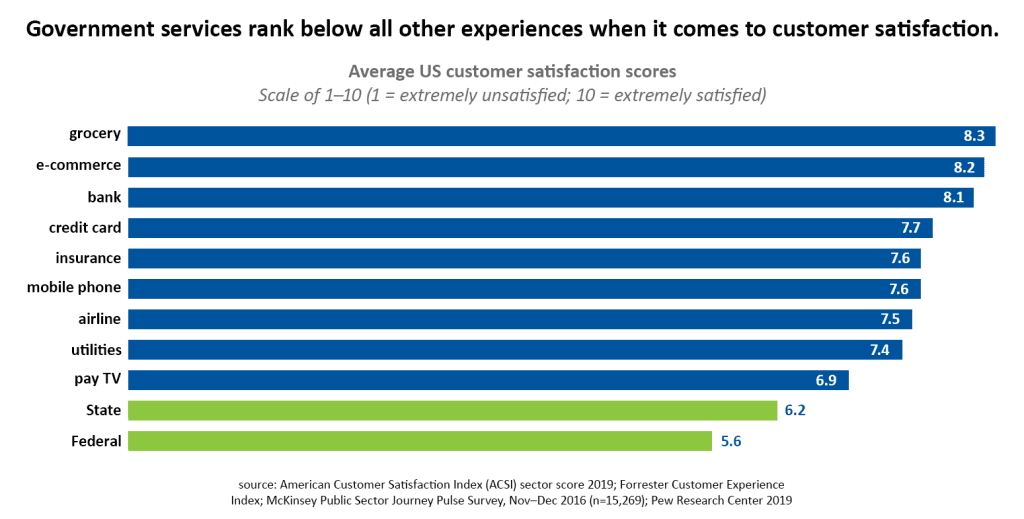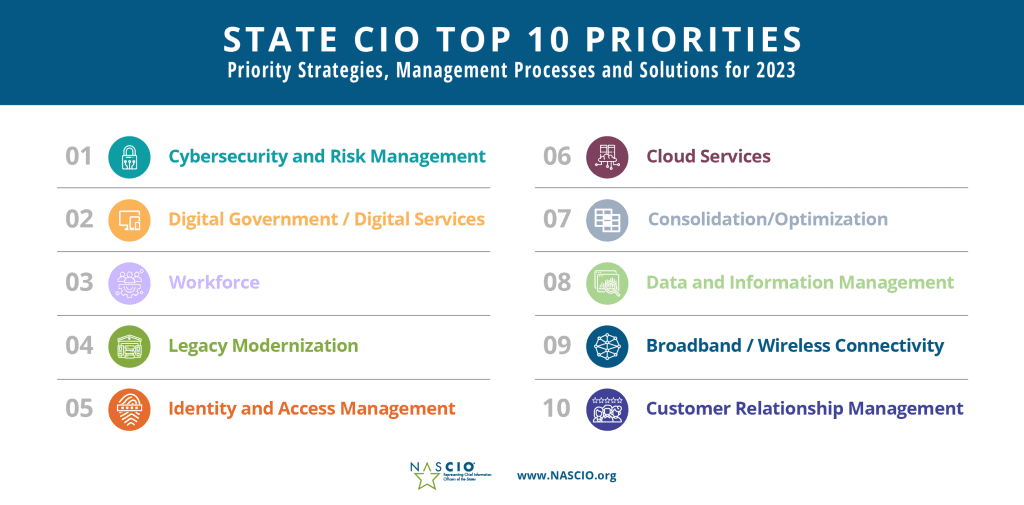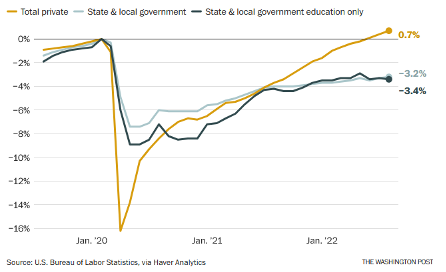State and Local Governments Are Moving Their Customer Experience (CX) to the Cloud

10 reasons why a move to the cloud is the answer to your communications challenges
For local government, just like any business or organization, customer experience is a big deal. Citizens expect the same level of quick resolution and availability when they call about their utility bill that they get with their Netflix account, if not higher. Missing these expectations can dissolve trust in the government and lower morale in the civil services—not to mention creating negative media coverage and increasing agency costs. State and local governments are facing a monumental customer experience challenge. So how are they doing? Not well. According to a McKinsey survey, state and federal governments rank dead last in satisfaction scores, behind airlines, car insurance, and cable TV. And if that’s not enough, as governments look for ways to solve their urgent customer experience challenges, they also must consider budgetary and staffing restrictions. It’s a tough task.

Behind this enormous challenge, though, is an opportunity. Smart government CIOs are looking for new processes and forward-thinking solutions that can help improve constituent services and communication. Some of these priorities include cybersecurity, workforce management, legacy modernization, remote services, data management, and customer service strategies. In fact, the National Association of State CIOs (NASCIO) conducts a survey every year and these areas top the list.

As customer experience and business communications experts, often our first recommendation when consulting government entities looking to tackle these priorities is to start by considering cloud solutions. Why do we see a cloud strategy as crucial to digital transformation as states and municipalities address their top priorities? Let’s take a look.
10 Ways Moving to the Cloud Improves Your Customer Experience
#1 Cloud keeps your current as legacy communications systems fade
We’ve been in this business for many years and we’re seeing some alarming warning signs from the classic leaders in our industry. Their focus has slipped due to economic problems and changing strategies. They are no longer the industry leaders—and no longer a sensible foundation for your future communications. Whether it’s Cisco laying off 5% of its workforce in November or Avaya declaring bankruptcy in February, that torch has been passed to cloud vendors like RingCentral and 8×8. These are the platforms that are providing the leading edge of technology and investing in the future. Your strategic thinking needs to shift accordingly.
#2 Cloud increases the number of channels you can interact in
According to a recent Customer Service Report, 68% of interactions with your constituents are still phone calls. But that’s changing. Chat is the third-fastest growing channel for support. 85% of respondents prefer texting. And 49% want to engage with e-mail. Providing more channels means you have the ability to meet your constituents where they want to engage. Switching between disparate tools, however, makes it harder to manage interactions. Luckily, cloud gives you an integrated way to add chat, SMS, and e-mail as engagement paths. Your constituents—and your agents—will thank you.
#3 Cloud offers the best remote experience for your workers
Cloud communications solutions offer the best experience for remote workers because the cloud architecture considers ALL users to be remote workers from their systems. In other words, the cloud is optimized to make the remote work experience as easy and secure as possible. For example, Vertical phones can be connected via ethernet or Wi-Fi. Once powered, the phones will automatically configure themselves. The phones can be drop-shipped directly to the end-user with no phone-side configuration. It’s that easy.
#4 Cloud helps you combat a workforce deficit and aging workers
A key priority for many governmental organizations is addressing staffing concerns. Government hiring has not rebounded the same way that business has. As you can see in the chart below, both state & local government and state & local education are down about 3%, while the private sector is seeing employment numbers grow.

Added to that, government workers are an aging population with more than half (52%) of public workers over age 45. You need to make your existing workforce more efficient, fill holes in the workforce, and attract and retain workers. There are a couple of ways that AI can integrate with your cloud contact center and help you do this:
- Empower workers with better data. Use AI to intelligently and quickly feed the right information to your workers when they engage with constituents.
- Help with note-taking. Capturing information is vital, but it’s hard to do that while simultaneously engaging with the contact. Agent assist goes beyond transcribing to summarize the key points.
#5 Cloud presents an enhanced experience for your workers
Cloud communication tools will enable your typical worker to get their jobs done more quickly and efficiently by reducing their workload and accelerating interactions. The best tools prioritize the end-user experience and focus on quickly adding new capabilities to respond to end-user needs, resulting in greater overall employee satisfaction. A survey by Slingshot found that 96% of employees saw their workplace software as inadequate. Providing better tools helps staff stay focused and accomplish more—keys to workplace satisfaction.
#6 Cloud centralizes your communications offerings
Complex services and multiple vendors can cause skyrocketing administration costs, reduce negotiating leverage, and lead to high integration costs for maintaining compatibility. Centralizing on a single cloud communications solution can greatly improve your Total Cost of Ownership (TCO). Vertical recommends focusing on a single platform that offers a complete array of solutions. We can even help you bundle best-of-breed solutions into a single bill, with a single contract, simplifying your procurement requirements.
#7 Cloud helps you integrate with other systems
Constituents want you to have all of their information directly at hand when they reach out. Connecting to third-party systems is crucial to making the entire interaction simpler. A great example of this is Padre Dam in California. They were having trouble supporting the campsites on their land because their reservation team used a third-party system to manage requests. Vertical custom-developed a simple integration with their 8×8 cloud contact center. Now, Padre Dam’s team has easy access to the reservation data when someone contacts them. It saves time and improves the capacity of their engagement team—resulting in very happy campers.
#8 Cloud allows you to automate engagement tasks
A common challenge in today’s government is handling frequent requests for information. Vertical has found that around a quarter of engagement tasks with constituents are really simple repetitive tasks that don’t need a human to accomplish. You need to (1) identify the tasks that make sense to automate and (2) build the automation around these engagements using cloud services like voice, chat, SMS, and e-mail. This will immediately reduce wait times and provide access to hard-to-find information. The key is having experts who can help you identify good candidate tasks, design the workflows that will accomplish them, and conduct regular check-ups to make sure these tools are accomplishing your goals.
#9 Cloud reduces your administration overhead
A major advantage of transitioning to cloud communications systems is the reduced administration overhead. With cloud, the maintenance and care of your underlying software infrastructure is outsourced to the vendor. Patch management, server maintenance, backups, testing, and much more are no longer your responsibility, allowing you to accomplish more with fewer resources. Additionally, cloud solutions offer a simplified administration experience. Legacy systems are complex and difficult to manage. With leading cloud systems, user experience is prioritized and simplified.
#10 Cloud reduces the surface area of potential security threats
Security is every agency’s #1 priority. Yet legacy communications infrastructure is a major potential attack vector. Because these solutions are based on older technology, they are no longer aggressively maintained. And it’s easy to get behind with upgrades when you have to find time to apply them to internal servers. Finally, most legacy solutions were simply never designed to handle remote work. Exposing LAN systems to public networks makes them more vulnerable. Cloud solutions address all of these challenges. The infrastructure is designed, by definition, with the security of remote workers in mind. It is maintained by the vendor and, as a subscription product, it provides constant software maintenance.
Conclusion
The move to cloud communications is never simple. But Vertical can help make it easy for your agencies and institutions. There are numerous ways we do this.
Backward Compatibility
As nice as it would be, you can’t move all of your many systems at the same time. Vertical’s team can help identify integrations that will help maintain compatibility as you transition systems.
Managing Integrations
As you develop integrations with your new cloud system, you can easily encounter roadblocks. The key is to have a partner like Vertical who can help you integrate securely and who has experience maintaining these connections over time.
Contract and Billing
Single-source solutions are great for cost control, but they make it harder for individual agencies to own and manage their costs. With Vertical, it’s possible to rebill services to agencies at a markup and provide the agreed-upon percentage to the IT organization.
The Vertical Difference
Many companies don’t understand government business. Vertical, on the other hand, specializes in working with state, local, and education entities. We understand the details of working with procurement departments, special contracting needs, and working in various states. In our previous article, we explained how Vertical’s deep experience, talented people, and meticulous process make Vertical uniquely positioned to help government agencies migrate to the cloud.
It’s all about the Vertical Difference. When you choose to partner with Vertical, your organization will get expert consultation, custom-designed solutions, and the best technologies. Our expert team is there with you throughout the on-site implementation. And after the platform is installed, we provide support and guidance to keep your system up-to-date and running smoothly. It’s the easy way for governments to maximize their resources and deliver the great customer experiences that their constituents are demanding.



